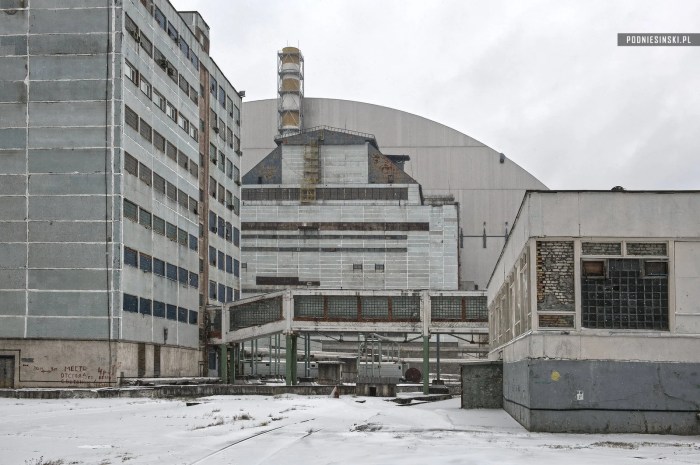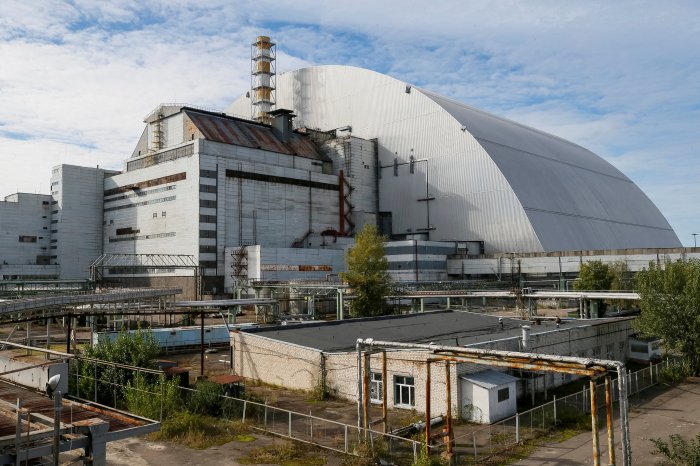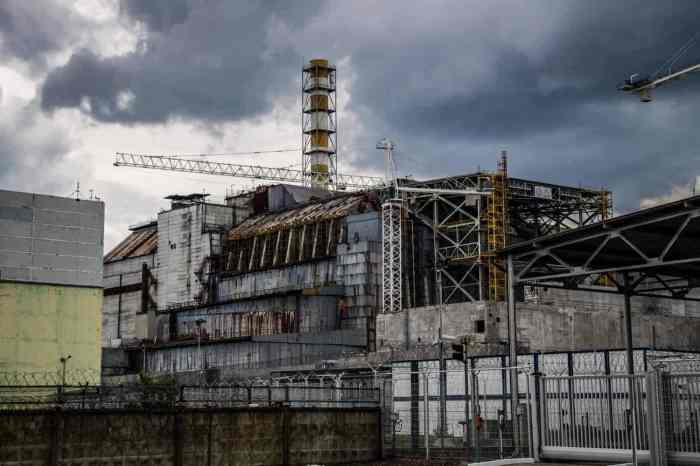The Chernobyl Power Plant, a name synonymous with disaster, has left an indelible mark on the world. This nuclear facility, once a symbol of Soviet technological prowess, became the site of the world’s worst nuclear accident, forever etching its name in the annals of history.
The Chernobyl Power Plant’s story is a complex tapestry woven with political ambitions, scientific hubris, and human tragedy. Its legacy continues to resonate today, raising questions about the safety of nuclear power and the responsibility we bear towards future generations.
Chernobyl Power Plant History
The Chernobyl Power Plant, located in northern Ukraine, holds a dark and infamous place in history. Its construction, operation, and eventual catastrophic accident have left an indelible mark on the world.
Construction and Development
In the 1970s, the Soviet Union embarked on an ambitious plan to expand its nuclear power generation capacity. As part of this effort, the Chernobyl Power Plant was constructed near the town of Pripyat, in the Ukrainian Soviet Socialist Republic.
The plant consisted of four RBMK-1000 reactors, a Soviet-designed type known for its high power output and inherent instability.
Political and Economic Influences
The development of the Chernobyl Power Plant was heavily influenced by political and economic factors. The Soviet government, under the leadership of Leonid Brezhnev, sought to showcase the country’s technological prowess and to meet its growing energy demands. Economic considerations also played a role, as nuclear power was seen as a cost-effective alternative to fossil fuels.
Commissioning and Operation
The first reactor at the Chernobyl Power Plant was commissioned in 1977, followed by the other three reactors in 1978, 1981, and 1983. The plant operated at full capacity for several years, supplying electricity to the surrounding region and to the Ukrainian grid.
However, concerns about the safety of the RBMK-1000 reactors had been raised by some experts, particularly regarding their tendency to experience power surges.
The Chernobyl Disaster
On April 26, 1986, a catastrophic accident occurred at the Chernobyl Power Plant during a safety test. A combination of design flaws, human error, and a lack of proper safety procedures led to a sudden power surge that caused the reactor core to explode.
The explosion released a massive amount of radioactive material into the atmosphere, contaminating a wide area of Ukraine, Belarus, and other parts of Europe.
Aftermath and Legacy
The Chernobyl disaster had a profound impact on the Soviet Union and the world. The immediate aftermath of the accident involved a massive evacuation of the surrounding area and the establishment of a 30-kilometer exclusion zone around the plant. The long-term effects of the radiation exposure have been devastating, with increased rates of cancer and other health problems among the affected populations.The Chernobyl disaster also had a significant impact on the global nuclear power industry.
The accident raised serious questions about the safety of nuclear power plants and led to a decline in the construction of new reactors. The disaster also highlighted the importance of nuclear safety and the need for strict regulations and oversight.Today, the Chernobyl Power Plant remains a symbol of the dangers of nuclear power and the importance of safety.
The exclusion zone around the plant is still heavily contaminated, and it is likely to remain uninhabitable for centuries to come. However, the plant itself has been decommissioned, and a new safe confinement structure has been built to prevent the release of further radioactive material.The Chernobyl disaster serves as a constant reminder of the importance of nuclear safety and the need for vigilance in the operation and maintenance of nuclear power plants.
Chernobyl Disaster
The Chernobyl disaster was a nuclear accident that occurred on 26 April 1986 at the Chernobyl Nuclear Power Plant in Ukraine. It is considered the worst nuclear disaster in history, and has had a profound impact on the lives of millions of people.
The disaster was caused by a combination of design flaws in the reactor, inadequate safety procedures, and human error. A series of explosions and fires released large amounts of radioactive material into the atmosphere, which spread across Europe and beyond.
Immediate Consequences
- The explosion and fire killed 31 people, and over 200 people were hospitalized with acute radiation sickness.
- The radioactive plume spread across Europe, contaminating soil, water, and food.
- The disaster led to the evacuation of over 100,000 people from the surrounding area.
- The long-term health effects of the disaster are still being studied, but it is known that the radiation exposure has increased the risk of cancer and other health problems.
Impact on the Local Population
- The disaster had a devastating impact on the local population.
- Many people were forced to leave their homes and livelihoods, and the area around the plant remains largely uninhabitable.
- The disaster has also had a significant impact on the mental health of the local population, with many people suffering from anxiety, depression, and other mental health problems.
Impact on the Environment
- The disaster has had a significant impact on the environment.
- The radioactive contamination has killed wildlife, damaged forests, and contaminated soil and water.
- The disaster has also led to a decrease in tourism and economic activity in the area.
Lessons Learned from Chernobyl

The Chernobyl disaster was a catastrophic nuclear accident that occurred in 1986 at the Chernobyl Nuclear Power Plant in Ukraine. The accident resulted in the deaths of 31 people and the release of large amounts of radioactive material into the environment.
In the aftermath of the disaster, a number of lessons were learned about nuclear safety, which have led to changes in the design and operation of nuclear power plants around the world.
One of the most important lessons learned from Chernobyl is the need for a strong safety culture in nuclear power plants. This includes a commitment to safety at all levels of the organization, from the plant manager to the individual workers.
It also includes a willingness to learn from mistakes and to make changes to improve safety.
Changes to Nuclear Power Plant Design and Operation
In response to the Chernobyl disaster, a number of changes were made to the design and operation of nuclear power plants. These changes include:
- The addition of containment buildings to prevent the release of radioactive material into the environment in the event of an accident.
- The installation of emergency core cooling systems to prevent the meltdown of the reactor core in the event of a loss of coolant.
- The development of new safety procedures and training programs for nuclear power plant workers.
International Cooperation and Collaboration
The Chernobyl disaster also led to increased international cooperation and collaboration in the field of nuclear safety. This cooperation has included the development of new safety standards and the sharing of information and expertise between countries.
The lessons learned from the Chernobyl disaster have helped to make nuclear power plants safer and more reliable. However, it is important to remember that nuclear power is still a potentially dangerous technology. It is essential that we continue to learn from our mistakes and to make changes to improve safety.
Current Status of the Chernobyl Power Plant

Today, the Chernobyl Power Plant is in a state of decommissioning, which is a complex and long-term process that involves dismantling the reactors, removing radioactive waste, and restoring the site to a safe condition.
The decommissioning process is being carried out by the Ukrainian government with the assistance of international organizations such as the European Bank for Reconstruction and Development (EBRD) and the World Bank.
Challenges of Decommissioning
The decommissioning of the Chernobyl Power Plant is a challenging and costly undertaking. The plant is highly radioactive, and the work must be carried out with great care to avoid any further accidents.
One of the biggest challenges is the removal of the radioactive waste from the site. The waste is stored in various locations around the plant, and it must be carefully removed and transported to a safe disposal site.
Another challenge is the dismantling of the reactors. The reactors are made of highly radioactive materials, and they must be dismantled in a way that minimizes the release of radiation.
Plans for the Future
The decommissioning of the Chernobyl Power Plant is expected to take several decades to complete. Once the decommissioning is complete, the site will be turned into a safe and environmentally friendly area.
There are several plans for the future of the Chernobyl site. One plan is to turn the site into a nuclear waste storage facility. Another plan is to create a museum or memorial to the victims of the Chernobyl disaster.
Cultural and Social Impact of Chernobyl

The Chernobyl disaster has had a profound cultural and social impact, shaping public perceptions of nuclear power and the role of technology in society. It has also inspired numerous artistic and literary responses.
Public Perception of Nuclear Power
The Chernobyl disaster has led to a widespread loss of trust in nuclear power. In many countries, there has been a decline in public support for nuclear energy, and several countries have abandoned or scaled back their nuclear programs. The disaster has also raised concerns about the safety of nuclear power plants and the potential for future accidents.
Role of Technology in Society, Chernobyl power plant
The Chernobyl disaster has also raised questions about the role of technology in society. Some critics argue that the disaster is a cautionary tale about the dangers of relying too heavily on technology. Others argue that the disaster could have been prevented if the plant had been properly designed and operated.
Artistic and Literary Responses
The Chernobyl disaster has inspired a wide range of artistic and literary responses. These responses include documentaries, films, books, and plays. Some of these works have sought to document the disaster and its aftermath, while others have explored the disaster’s broader cultural and social implications.
Chernobyl in Popular Culture
The Chernobyl disaster has been widely portrayed in popular culture, including in film, television, and literature. These representations have had a significant impact on public understanding of the disaster and its consequences.
One of the most well-known depictions of Chernobyl is the 2019 HBO miniseries “Chernobyl.” The series follows the events leading up to and after the disaster, and it has been praised for its accuracy and attention to detail. The series has also been credited with raising awareness of the disaster and its long-term effects.
Film and Television
In addition to “Chernobyl,” there have been a number of other films and television shows that have depicted the disaster. These include the 1987 Soviet film “The Battle of Chernobyl” and the 2006 BBC documentary “Chernobyl: The Lost Tapes.” These productions have helped to bring the story of Chernobyl to a wider audience and have contributed to a greater understanding of the disaster.
Literature
Chernobyl has also been the subject of a number of works of literature. These include Svetlana Alexievich’s 1997 book “Voices from Chernobyl” and Adam Higginbotham’s 2019 book “Midnight in Chernobyl.” These works have provided readers with a more personal and intimate look at the disaster and its aftermath.
The portrayal of Chernobyl in popular culture has played an important role in shaping public understanding of the disaster. These representations have helped to raise awareness of the disaster and its consequences, and they have also contributed to a greater understanding of the human toll of nuclear accidents.
Chernobyl and Nuclear Power Today
The Chernobyl disaster has had a profound impact on the nuclear power industry worldwide. In the aftermath of the accident, many countries reassessed their nuclear power programs and implemented new safety measures.
Today, nuclear power remains a significant source of electricity generation in many countries. However, the industry faces a number of challenges, including:
Public Perception
The Chernobyl disaster has led to widespread public concern about the safety of nuclear power. This has made it difficult for some countries to build new nuclear power plants or to extend the operating licenses of existing plants.
Economics
Nuclear power plants are expensive to build and operate. This has made it difficult for nuclear power to compete with other sources of electricity, such as natural gas and renewable energy.
Safety
The Chernobyl disaster highlighted the importance of nuclear safety. Since then, the nuclear industry has made significant progress in improving the safety of nuclear power plants.
Despite these challenges, nuclear power remains an important part of the global energy mix. Nuclear power plants produce a large amount of electricity with relatively low greenhouse gas emissions.
The future of nuclear power is uncertain. However, the industry is working to address the challenges it faces. If these challenges can be overcome, nuclear power could play a major role in meeting the world’s future energy needs.
Epilogue
The Chernobyl Power Plant stands as a haunting reminder of the potential consequences of unchecked technological advancement. Its legacy serves as a cautionary tale, urging us to approach nuclear power with utmost care and to prioritize safety above all else.
As the world continues to grapple with the challenges of energy production, Chernobyl’s lessons remain invaluable, guiding us towards a more sustainable and responsible future.
FAQ Insights
What were the main causes of the Chernobyl disaster?
The Chernobyl disaster was caused by a combination of design flaws, safety violations, and human error. A flawed reactor design, coupled with a poorly trained staff and a lack of safety protocols, led to a catastrophic chain of events.
What was the immediate impact of the Chernobyl disaster?
The immediate impact of the Chernobyl disaster was the release of large amounts of radioactive material into the atmosphere. This resulted in widespread contamination of the surrounding area and the evacuation of over 100,000 people. The disaster also had a devastating impact on human health, causing acute radiation sickness and an increased risk of cancer.
What are the long-term effects of the Chernobyl disaster?
The long-term effects of the Chernobyl disaster include an increased risk of cancer, particularly thyroid cancer, among those exposed to high levels of radiation. The disaster also caused widespread environmental damage, contaminating soil and water sources, and disrupting ecosystems.